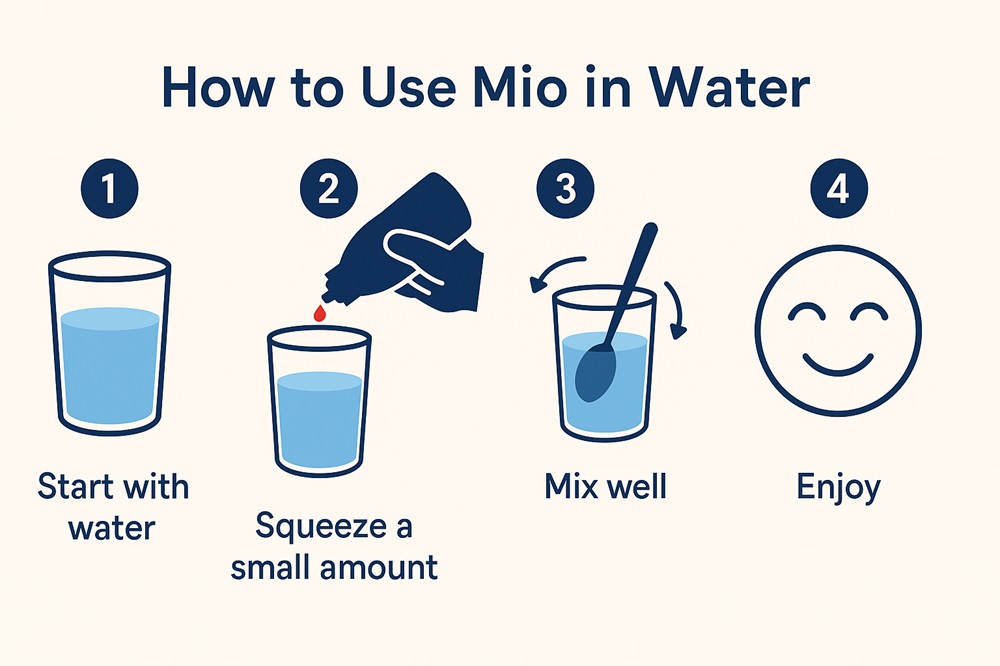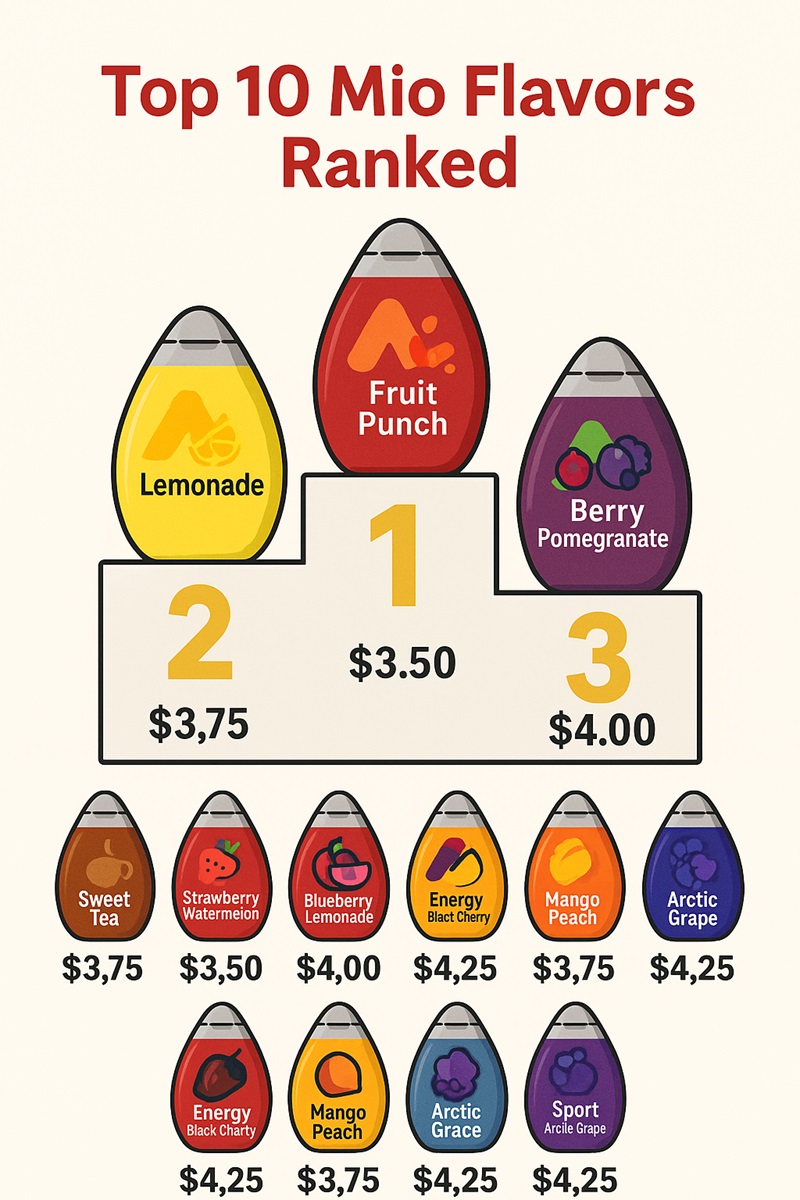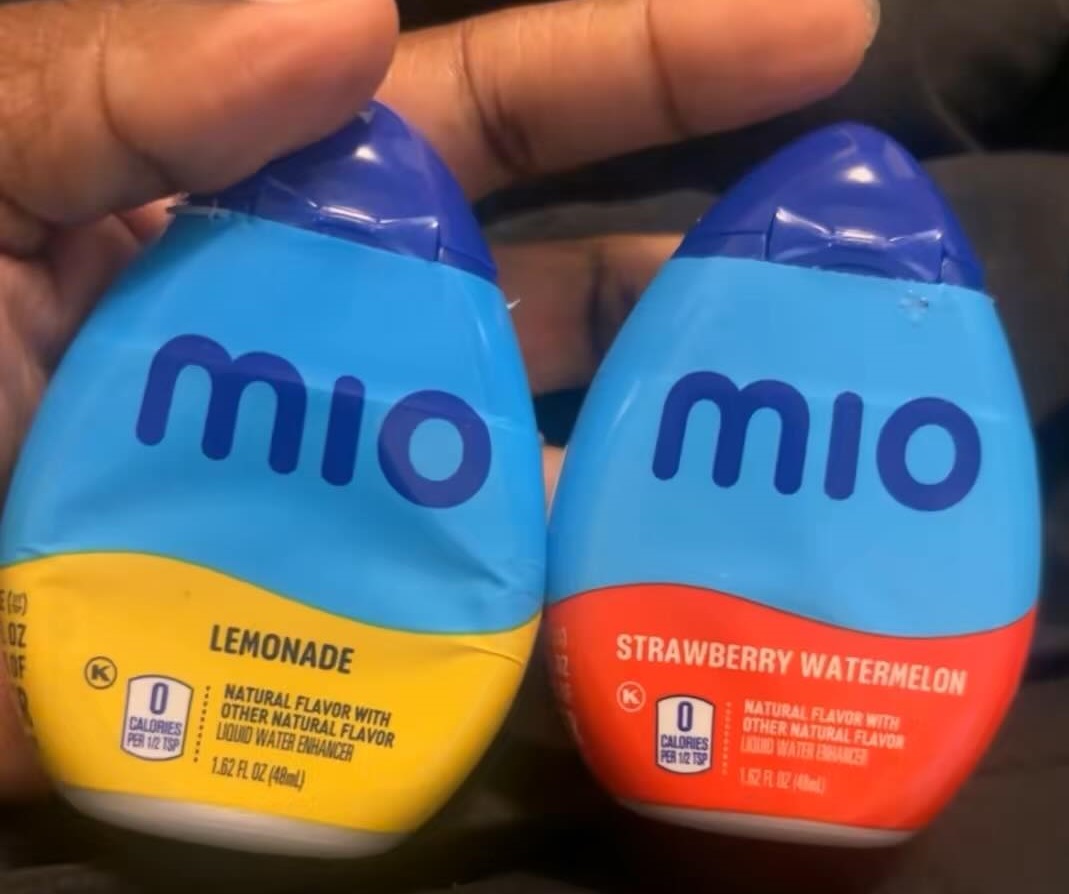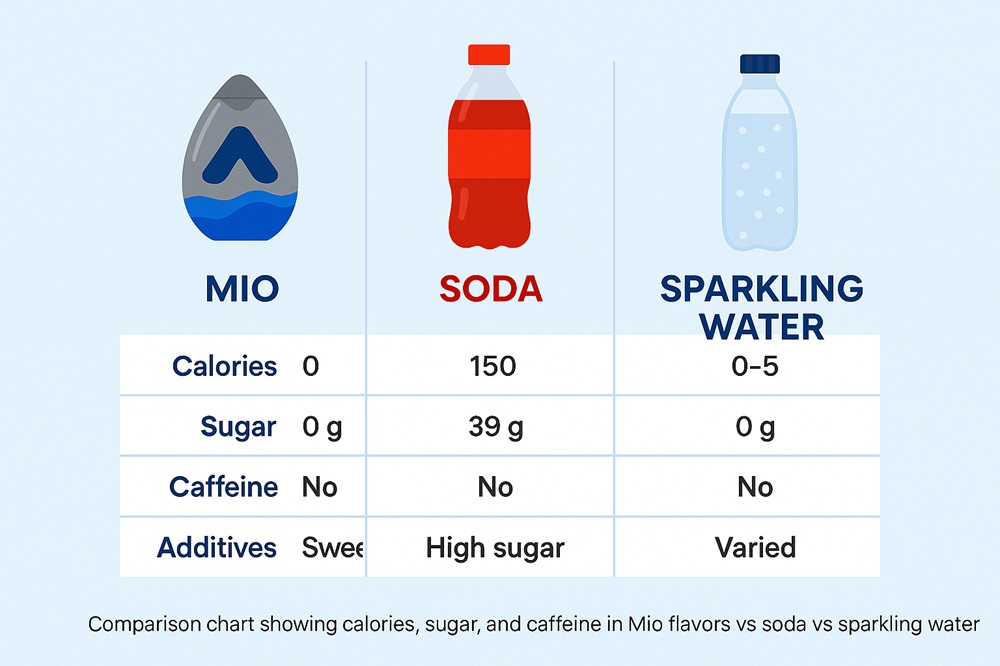Mio flavors have become a popular way to make plain water more exciting. Just a few drops can turn your glass into a fruity, refreshing drink — without the calories of soda or juice. But many people wonder: are Mio flavors actually good for you, or do they come with hidden health risks?
What Are Mio Flavors?
Mio is a brand of liquid water enhancers made by Kraft Heinz. The product line is designed to add taste, vitamins, or caffeine to plain water.
The main categories include:
- Mio Original – flavored water enhancers without calories.
- Mio Energy – includes caffeine and B vitamins for a boost.
- Mio Vitamins – contains added vitamins like B, C, and E.
- Mio Sport – adds electrolytes for hydration during exercise.
Popular flavors include Fruit Punch, Lemonade, Berry Pomegranate, Tropical Fusion, and many seasonal limited editions.

How to Use Mio in Water
Mio is designed to be quick and easy to use. The product comes in a small squeeze bottle with a controlled nozzle that lets you add just the right amount to your drink.
- Start with water – Fill a glass, reusable bottle, or pitcher with cold or room-temperature water.
- Squeeze a small amount – A short squeeze (about ½ teaspoon or one squirt) flavors 8 oz of water. The bottles are concentrated, so a little goes a long way.
- Adjust to taste – If you like stronger flavor, add a bit more. For a lighter taste, use less.
- Mix well – Stir or shake your bottle so the flavor distributes evenly.
- Enjoy responsibly – Most bottles make around 24 servings, and flavors can be added to plain still water or sparkling water.
Tips:
- Don’t add too much at once — over-concentration can make the taste bitter or overly sweet.
- Mio can also be added to soda water for a DIY flavored sparkling drink.
- For athletes, the Mio Sport line works well in reusable sports bottles for hydration during workouts.
⚠️ Note: Avoid mixing Mio with hot liquids, as the product is designed for cold or room-temperature water and may lose flavor quality when heated.
Nutrition Facts of Mio Flavors
Here’s what you’ll typically find in a serving of Mio:
- Calories: 0–10 per serving
- Sugar: 0 grams (uses sucralose and acesulfame potassium)
- Caffeine (Energy line): 60 mg per serving (similar to a small cup of coffee)
- Vitamins/Electrolytes: Added in specific product lines
Quick Comparison Table
| Drink | Calories (8 oz) | Sugar (g) | Caffeine | Additives |
| Mio (Original) | 0 | 0 | No | Sweeteners |
| Mio Energy | 0 | 0 | 60 mg | Sweeteners, caffeine |
| Regular Soda | 100–150 | 25–40 g | No | Sugar, preservatives |
| Flavored Sparkling Water | 0–10 | 0 | No | Natural/varied |
| Infused Water | 0 | 0 | No | None |
FDA Approval: Is Mio Regulated?
Mio is classified as a “beverage enhancer” and falls under FDA food and beverage regulations. This means:
- All ingredients used in Mio must be on the FDA’s GRAS (Generally Recognized as Safe) list.
- Sweeteners such as sucralose and acesulfame potassium are FDA-approved for use in foods.
- Caffeine in Mio Energy is regulated under the same limits as sodas and energy drinks.
- Nutrition facts and ingredient disclosures must comply with FDA labeling rules.
Important note: FDA approval means ingredients are considered safe at typical consumption levels, but it does not automatically mean a product is “healthy.”
Ingredient Breakdown of Mio Flavors
While ingredients vary by line, here are the most common:
- Water – base of the formula
- Citric Acid – tartness + preservative
- Natural & Artificial Flavors – provide taste profiles
- Sucralose & Acesulfame Potassium – zero-calorie sweeteners
- Caffeine (Mio Energy) – about 60 mg per serving
- Sodium Benzoate & Potassium Sorbate – preservatives
- Food Coloring (FD&C dyes) – e.g., Red 40, Blue 1
- Vitamins (in some versions) – B3, B6, B12, C, E
- Electrolytes (Mio Sport) – sodium & potassium
Quick Ingredient Chart
| Ingredient | Purpose | Notes |
| Sucralose & Acesulfame K | Sweeteners | FDA-approved; may cause sensitivity in some |
| Citric Acid | Flavor + preservative | Safe, but acidic; can erode enamel in excess |
| Sodium Benzoate | Preservative | Safe in small amounts; some link with sensitivities |
| Artificial Colors | Appearance | FDA-approved; some avoid due to hyperactivity concerns |
| Caffeine | Stimulant | 60 mg per serving; safe in moderation |
| Added Vitamins/Electrolytes | Nutrition support | Varies by product line |
Benefits of Mio Flavors
- Encourages water intake for those who struggle with plain water.
- Zero– or low-calorie alternative to soda and juice.
- Portable and convenient.
- Wide variety of flavors prevents taste fatigue.
According to the CDC, replacing sugary drinks with water (including flavored zero-calorie options) is one of the easiest ways to reduce daily calorie intake.
Health Concerns and Risks
Artificial Sweeteners
Research from the Mayo Clinic and NIH shows sucralose and acesulfame potassium are generally safe, but some studies suggest possible effects on gut bacteria, cravings, or mild digestive discomfort.
Caffeine Overuse
Mio Energy has 60 mg per serving. The FDA recommends no more than 400 mg caffeine per day for adults. Too many servings can lead to jitters, anxiety, or sleep problems.
Not Ideal for Everyone
- Children: best to avoid due to sweeteners and caffeine.
- Pregnant/breastfeeding women: consult a healthcare provider.
- People with sensitivities: some report headaches, bloating, or reactions to preservatives.
Are Mio Flavors Good for You?
The short answer: Mio flavors can be good for you in moderation, but they’re not a “health drink.”
✅ Good for you if:
- You struggle to drink plain water.
- You want to cut back on soda or high-calorie drinks.
- You use them occasionally as a flavor boost.
❌ Not ideal if:
- You rely on them daily instead of enjoying plain water.
- You’re sensitive to artificial sweeteners or caffeine.
- You’re giving them to kids as a primary hydration source.
Verdict: Mio can support hydration and reduce sugar intake, but plain water and naturally flavored alternatives remain the healthiest long-term choice.

Top 10 Mio Flavors Ranked
Mio Fruit Punch
Fruit Punch is the classic starter flavor for many Mio fans. It has a sweet, fruity taste without the sugar of juice. A 1.62 fl oz bottle costs about $3.50–$4.00 and makes 24 servings. That’s far cheaper than buying bottled punch. It’s calorie-free but contains artificial sweeteners, which some people may want to limit.
Mio Lemonade
Lemonade gives the crisp, tangy taste of classic lemonade without sugar. It’s a top choice for people replacing soda or sweet lemon drinks. At around $3.75 per bottle, it’s affordable and makes flavored water cheaper than canned lemonade. One note: frequent citric acid may affect tooth enamel over time.
Mio Berry Pomegranate
Berry Pomegranate offers a bold, tart flavor that feels less predictable than Fruit Punch or Lemonade. It costs about $4.00 per bottle and appeals to people who like variety. Like other flavors, it’s calorie-free but uses sweeteners that may cause mild stomach upset in some users.
Mio Orange Tangerine (Vitamins Line)
This citrus flavor is part of the Mio Vitamins line. It includes added vitamins like B, C, and E. Health-conscious buyers often choose it for the extra benefits. At $4.25 per bottle, it costs a bit more than standard flavors but is still cheaper than bottled vitamin water.
Mio Sweet Tea
Sweet Tea mimics the smooth taste of Southern iced tea without sugar. It’s popular in regions where sweet tea is a tradition. Priced at $3.75–$4.00, it’s an affordable alternative to bottled tea. Some users note a slightly artificial aftertaste if too much is used.
Mio Strawberry Watermelon
This light and refreshing blend is a summer favorite. Both kids and adults enjoy it. At $3.50 per bottle, it’s one of the most affordable options. The only drawback is the use of food dyes, which some families avoid.
Mio Blueberry Lemonade
Blueberry Lemonade mixes tart lemon with berry sweetness. Fans like it because it stands out from standard citrus flavors. It usually costs $4.00–$4.25. Like others, it’s calorie-free but uses sweeteners and additives, so moderation is best.
Mio Energy Black Cherry
Part of the Mio Energy line, this flavor combines bold taste with caffeine (60 mg per serving). It’s popular with students, gamers, and shift workers. At $4.25–$4.50 per bottle, it’s a bit more expensive but doubles as an energy drink alternative. Just watch total caffeine intake.
Mio Mango Peach
This tropical mix is smooth, sweet, and always among fan favorites. At about $3.75–$4.00 per bottle, it’s cheaper than bottled tropical juices. Like other fruity flavors, it uses artificial coloring but remains calorie-free.
Mio Sport Arctic Grape
Designed for athletes, Arctic Grape includes electrolytes for hydration. Its bold grape taste makes it a top post-workout choice. At $4.25 per bottle, it’s more affordable than most sports drinks. Still, it contains dyes and sweeteners, which some users may want to limit.
Healthy Alternatives to Mio Flavors
If you prefer natural hydration:
- Fruit-infused water with lemon, cucumber, or berries.
- Unsweetened sparkling water like LaCroix or Bubly.
- Electrolyte powders/tablets (e.g., Nuun, Liquid I.V.).
- DIY natural drops: lemon or lime juice for a quick, clean boost.
Environmental & Packaging Considerations
Mio bottles are made of plastic and are typically recyclable (#1 PET plastic), but sustainability-conscious consumers may prefer refillable infuser bottles or natural flavoring methods. Compared to soda bottles, Mio produces less packaging waste overall, but still contributes to single-use plastic.
FAQs
Do Mio flavors have sugar?
No. They are sweetened with sucralose and acesulfame potassium.
Can Mio help me lose weight?
Yes. Replacing soda with Mio reduces calorie intake. Just avoid overuse.
Does Mio break a fast?
No calories or carbs, so it’s generally considered fasting-friendly — but caffeine may affect insulin sensitivity for some.
Is Mio keto-friendly?
Yes. Mio is sugar-free and contains no net carbs, making it suitable for low-carb and keto diets.
Are Mio flavors safe for kids?
Not recommended due to artificial sweeteners and, in some cases, caffeine.
Is Mio better than soda?
Yes — Mio has no sugar and far fewer calories, though water or natural infusions are even better.
Which Mio flavor is healthiest?
Options without caffeine and with added vitamins, such as Mio Vitamins Orange Tangerine, may be the best pick.
How many servings are in a Mio bottle?
One 1.62 fl oz bottle makes about 24 servings, costing roughly 15–20 cents per serving.
Conclusion
Mio flavors make water more enjoyable, help cut soda cravings, and add taste without extra calories. They are FDA-approved and safe when used in moderation. Still, they are not a perfect health choice. Artificial sweeteners, caffeine, and heavy use may cause problems for some people.
Bottom line: Mio is healthier than soda, good for hydration, and easy on the budget. But plain water, fruit-infused water, or natural drinks are still the best options for long-term health.





